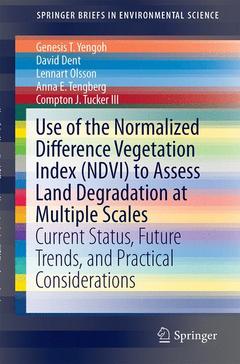Use of the Normalized Difference Vegetation Index (NDVI) to Assess Land Degradation at Multiple Scales, 1st ed. 2016 Current Status, Future Trends, and Practical Considerations SpringerBriefs in Environmental Science Series
Auteurs : Yengoh Genesis T., Dent David, Olsson Lennart, Tengberg Anna E., Tucker III Compton J.

The report reviews the use of NDVI for a range of themes related to land degradation, including land cover change, drought monitoring and early warning systems, desertification processes, greening trends, soil erosion and salinization, vegetation burning and recovery after fire, biodiversity loss, and soil carbon. This SpringerBrief also discusses the limits of the use of NDVI for land degradation assessment and potential for future directions of use.
A substantial body of peer-reviewed research lends unequivocal support for the use of coarse-resolution time series of NDVI data for studying vegetation dynamics at global, continental and sub-continental levels. There is compelling evidence that these data are highly correlated with biophysically meaningful vegetation characteristics such as photosynthetic capacity and primary production that are closely related to land degradation and to agroecosystem resilience.
David Dent is an Honorary Fellow of Lund Centre for Sustainability Studies. Previously, he served as Director of ISRIC-World Soil Information. He consults in scientific, practical and policy aspects of use and management of land resources to governments, international organizations, multinationals and private companies, working in every continent.
Lennart Olsson is the Founding Director of LUCSUS – Lund University Centre for Sustainability Studies. He serves as Scientific Director and Examiner of the International Masters Program LUMES. He teaches courses on land use, environmental modeling, water issues, natural resources and land degradation.
Anna Tengberg is an Environment and Development Consultant. She also serves as a Research Associate at the University of Gothenburg, Sweden’s Environmental Economics Unit as well as an Adjunct Professor at the Lund University Centre for Sustainability Studies.
Compton James Tucker III is a Physical Scientist at the Hydrospheric and Biospheric Sciences Laboratory at the NASA/Goddard Space Flight Center in Maryland, USA. He was among the first researchers to employ coarse-resolution satellite data to exploit the time domain for studying global photosynthesis on land, determining land cover, monitoring droughts, providing famine early warning, and predicting ecologically-coupled disease outbreaks.
Examines the scientific basis for the use of remotely sensed data, particularly Normalized Difference Vegetation Index (NDVI), primarily for the assessment of land degradation at different scales and for a range of applications, including resilience of agro-ecosystems
Draws evidence from peer-reviewed literature and interviews with leading specialists
This report was commissioned by the Scientific and Technical Advisory Panel of the Global Environment Facility (STAP/GEF)
Date de parution : 12-2015
Ouvrage de 110 p.
15.5x23.5 cm
Disponible chez l'éditeur (délai d'approvisionnement : 15 jours).
Prix indicatif 58,01 €
Ajouter au panier


